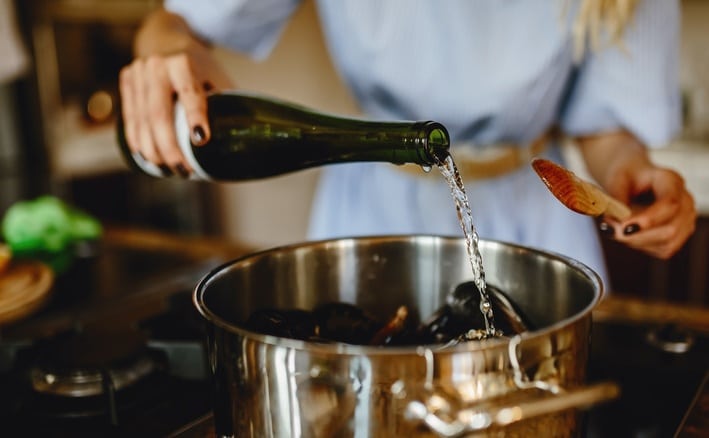Dr Justus Apffelstaedt: On cooking with wine – the scientific basis
By Justus Apffelstaedt, 16 October 2025

1
“I always cook with wine and sometimes I also put it into the food.” This quote is attributed to WC Fields who could be termed the father of American comedy. This made me think about why we put wine into food and what the biologic effects would be. Wine is in essence put into food for 3 reasons: 1. To add acidity 2. To soften proteins, notably meat 3. To provide taste in food.
Before the merits of these three points are discussed individually, one cannot avoid discussing the fate of alcohol in food. This is done easily; the alcohol is already diluted with the addition to the food; depending on the cooking time and the other ingredients it is further diluted with it boiling off much faster than water due to its lower boiling point (78 C° vs 100 C°). So, after a 15-minute simmer only about 40% of the alcohol remains, after 1 hour 25%, and 2 hours 10% is left. So, from your bottle of red (14% ABV) that you put into the Boeuf Bourguignon of 1.5 kg meat without adding any other fluid after 2 hours of gently simmering about 8.4 g will be left; each of the 8 portions for you and your friends will contain about 1 g of alcohol which is negligible.

If you add an acidic white wine to a creamy sauce for the mussels in white wine, malic and tartaric acid of the wine will aid hydrolysis of fats in the sauce. Biochemically, fat molecules consist of 3 fatty acid molecules bound to one glycerol molecule. The resulting fat molecule is water repellent and likes to sit on the mouth mucosa; in hydrolysis the fatty acids are released from glycerol. The effect is that the creamy sauce loses much of its mouthcoating feel as fatty acids as such dissolve better in saliva than the much larger fat molecules: The sauce becomes much more digestible. This is also the reason, why white (!) wine is added to a traditional Ragu Alla Bolognese.
Let’s return to the Boeuf Bourguignon: It started as a harvest tradition in Burgundy; at the end of harvest, farm workers had a communal meal to celebrate. They had to make do with rather tough cuts of beef and tenderized these by simmering in Pinot Noir. The tannins interact with the collagen – the white stuff that makes up tendons and connective tissue in meat and makes it tough to chew – by dissolving bonds in its matrix; collagen is broken down to gelatine. This has the added effect of conserving moisture and thus preventing the meat from drying out. Furthermore, muscle fibers are released from their connective tissue matrix and voila: The meat becomes tender, moist and easily digestible. But this is not the only action of tannins: They also interact with fat facilitating breakdown of fat molecules. Once again, the dilution of the tannins and their precipitation with the proteins will make any health effect as anti-oxidants very unlikely.
As for the provision of taste, in a Zabaglione sweet white wine is used to enhance taste. To believe that one would taste whether the zabaglione is made with Moscato di Asti or Marsala is a little preposterous: During the preparation in a bain-marie the chemical substances that are the basis of the delicate aromas of the especially aromatic white wines mostly evaporate very fast as many of the esters making up the aromas are even more volatile than alcohol; the taste profile of the wine is thus thoroughly changed. The sweetness and the acidity remain creating a tension on the palate that makes this light and fluffy dessert so delicious. This also means, that in general you should hold that bottle Romane-Conti to enjoy it with the meal instead of pouring it into the pot; any wine of basic quality that is not off is good enough for cooking.
The weather has turned cold again here in Cape Town; therefore, a delicious Rheinischer Sauerbraten is very slow cooking in the oven: 2.5 kg of very tough 1st rib in a bottle of red wine (a good papsak Pinotage) and a bottle of basic Calitzdorp Cape Ruby with root vegetables has been simmering at 80 deg for the last 12 hours. The tannins of both wines will tenderize the very tough meat and keep it moist; both tannins and acid of the wines will assist in breaking up the fats and assist digestion; I’ll balance the sugar of the port with some red wine vinegar to achieve the sweet and sour balance that makes a good Sauerbraten. I will sign off now to enjoy it. Cheers to that!
- Dr. Justus Apffelstaedt is a specialist in breast and thyroid health, leading Apffelstaedt & Associates in Cape Town and Windhoek. A surgeon with a specific interest in surgical oncology and researcher, he was Associate Professor of Surgery at Stellenbosch University (1994–2017) and Head of Surgical Oncology, managing 1,000-plus cancer cases annually. He has more than 50 publications, shaped South Africa’s breast cancer screening policy, and co-founded Breast Surgery International. A sought-after speaker, he has given over 100 international lectures. He also holds an MBA and a Diploma in Wine. Through Apffelstaedt & Associates, he continues to advance specialized, patient-centered care in Southern Africa.







Melvyn Minnaar | 17 October 2025
Thanks Justus, what a joyful, informative piece of ‘common cooking sense’ writing! Now we know why we do it. The Sauerbraten sounds delicious.